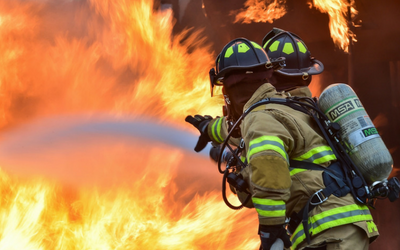
Have you made a fire evacuation plan for your family? Did you include your pets? July 15th is Pet Fire Safety Day – a reminder to pet owners to include their pets in fire evacuation plans and to take special precautions to prevent pet-related fires from starting.
Dogs and cats can increase the risk of home fires. A few simple steps can help you prevent pet related fires:
- Unattended candles are dangerous in any situation, but with pets around, all it takes is a quick flick of a tail to topple a lit candle and start a fire. Never leave candles burning unattended and keep all open flames out of reach of curious dogs and cats. Consider using flameless, battery-powered candles instead.
- Keep flammable liquids and cleaners in protected cupboards or cabinets, out of reach of your pets. Besides being fire hazards, they are usually toxic to pets if swallowed.
- In cold months, monitor your pet around the fireplace. While most pets will not approach a hot fire, they can sometimes nudge or scoot their beds or toys too close to a fire. These items can easily ignite if a hot ember lands on them.
- Keep electrical cords out of reach of pets. Dogs, cats, rabbits, and other pets that chew on the wires can not only suffer electrical burns to their mouth or die from electrocution, they can also remove the protective insulation, resulting in sparks and possibly a house fire.
It is important to include your pets in your family’s fire evacuation plans and by including them, you can reduce the risk of injury to your pet in a house fire.
- Pets often perish in house fires because they are confined to their crates and cannot escape. Stickers or decals alerting firefighters that pets reside in your home are available from many retail outlets. The SPCA carries pet rescue window decals as well; contact your local branch for more information.
- Include your pet in your evacuation plans. Teach all family members the safest way to escape your home in case of fire. Always have a back-up route in case the original path is blocked by flames or smoke. Practice your home evacuation plan twice a year during the day and at night – things look a lot different at night. Always keep a leash close to your pet’s crate or bed to help guide your dog to safety and restrain him if he becomes distraught. Never go back inside a burning building to retrieve a family member or pet. Get out and stay out. Call the fire department as soon as you are safely outside.
- If you are unable to escape with your pets, let the emergency responders know that your pets are still inside your home.
- As part of your pet fire safety preparations, make sure your pet is microchipped. If your pet escapes the fire or slips away during evacuation, it will be much easier to be reunited with him if he is microchipped. Be sure to update the contact information associated with the microchip so that you can be contacted.
If your pet is having difficulty breathing, ask emergency workers to provide oxygen support. Many rescue vehicles are equipped with oxygen masks specially made for dogs and cats. Be sure to have your pet checked out by your veterinarian after the fire. If your pet smells like smoke, he likely inhaled some too. Even if he appears normal, it is important that he be examined, as burns are sometimes not apparent under the thick coat of fur.
Losing a home to a fire is devastating. Losing a pet will make a difficult situation even worse. By taking these precautions, you can help protect your entire family in case of fire.